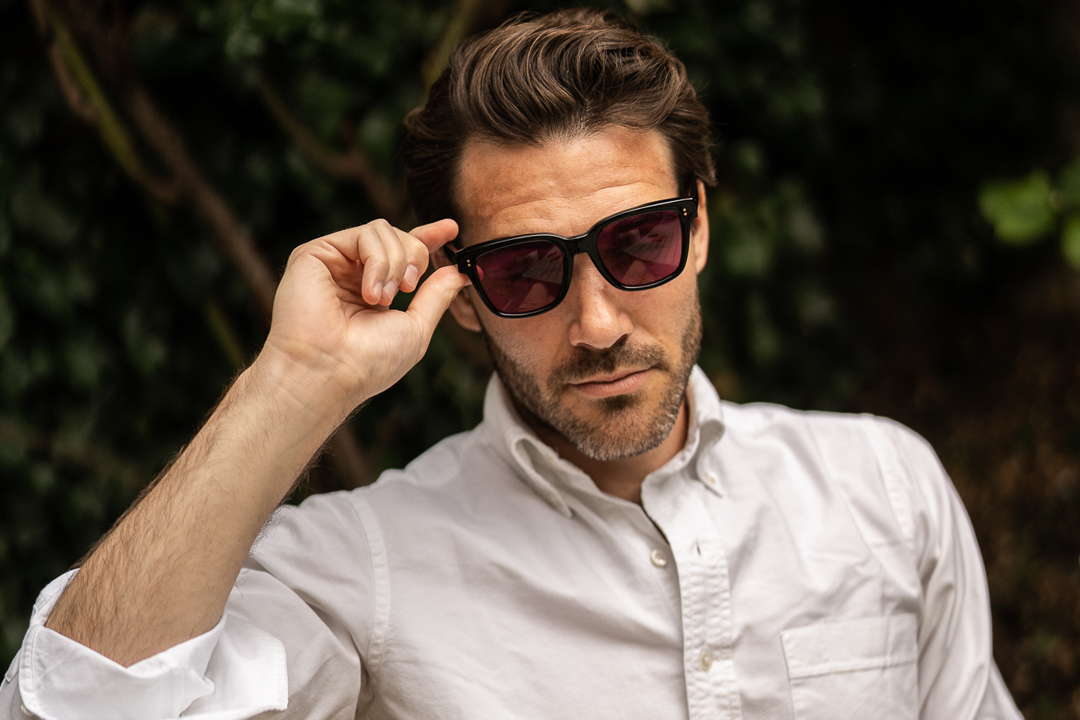Polarized help to reduce the effects of eyestrain and migraines because of their ability to block glare from flat, reflective surfaces such as water or snow. By diminishing harsh reflections, they’re usually the best option for consistent (glare-free) vision on bright sunny days, near water, or during long periods of sun exposure.
However, some claim that polarized lenses can actually cause headaches, which contradicts their reputation as a superior type of sun lens. Digging deeper, this article explores the various factors that may cause this side effect.

#1 Poorly fitting frame
One of the reasons why people end up with headaches while wearing polarized sunglasses is because of something called a "light leak." This phenomenon occurs when your sunglasses don't fit properly, allowing sunlight to enter the eyes from either the side or from above the edges of your frame.
Excess light entering the eyes, causes strain as you squint to try to see. The truth is that polarized glasses are intended to filter horizontal light waves that are produced when rays are reflected off a surface. However, when you wear sunglasses that are loose, sunlight can still get to yours eyes, putting them under strain from both visible light and invisible UV.
By ensuring a proper fit, you can prevent this from happening. If you intend to purchase your sunglasses for sporting activities, it's important to ensure that you are choosing frames designed especially for this purpose.
Sports sunglasses typically feature a strong frame curvature to prevent polarized light from getting into the eye. Some also have features such as side shields to prevent light leaks.
#2 Bounce back
One of the side effects of fashion orientated sunglasses with flat frame curvatures is the occurrence of 'bounce back'. This is when rays of light get between your eyes and the rear surface of the lenses, reflecting backwards.
Once again, this puts further strain on the eyes, causing headaches and discomfort. The bounce-back effect is a common problem with low-base curvature sunglasses and often occurs with fashion frames that have very flat frame fronts.
Fortunately, this issue can be solved with sun lenses that feature a rear-surface anti-glare coating. Like a two way mirror, this coating allows visible light to move forwards out of the lenses rather than being reflected back into your eyes.
#3 Wrong lens category
Another reason why people end up with headaches while wearing polarized or non-polarized sunglasses is because they choose the wrong lens category.
Before we go further, let's answer the question you're probably wondering right now: "What is a lens category?" Sunglasses are broken down into five groups, depending on the darkness of their tint.
Lightly tinted lenses don't absorb a lot of visible light, which can cause you to squint and strain your eyes when trying to see in bright conditions.
While short-term exposure won't likely produce too much discomfort, prolonged exposure could cause headaches.
To prevent this, make sure you choose sun lenses with a suitable level of darkness. Whether they're polarized or not, the darker the tint, the more visible light they'll absorb.
For most applications, we recommend category 3 sun lenses (around 80-85% absorption) which provide sufficient darkness for optimal visual comfort.
See the table below as a guide;
|
Category |
0 |
1 |
2 |
3 |
4 |
|
ABS% |
0% - 10% |
10% - 20% |
20% - 43% |
43% - 85% |
85% – 92% |
|
Tint |
Very light |
Light |
Marginal |
Dark |
Very dark |
|
Sun use |
Overcast |
Low |
Moderate |
Strong |
Very strong |
|
Driving suitability |
Day & night |
Day only |
Day only |
Day only |
Never |
#4 Light sensitivity
Photophobia (light sensitivity) is a common cause for headaches. People who have this condition have an abnormal sensitivity to light, and symptoms can range from mild discomfort, irritation or even severe pain in reaction to different light sources.
Exposure to light, especially bright or intense light, can cause sufferers to overstimulate their optic nerves, which can interfere with their brain's normal ability to process visual data.
A series of neurological reactions, such as the release of neurotransmitters and the triggering of pain pathways, can be set off by this sensory overload, which can eventually result in the onset of headaches.
Wearing polarized glasses can help to manage symptoms and prevent pain and discomfort. Because polarized lenses block horizontal light and reduce glare, they can lessen the strain on the eye. If you don't have polarized sunglasses, opt for lenses with dark tints ranging between 80-85% ABS.

#5 Lack of UV protection
The wavelength and energy of visible light and ultraviolet (UV) light are different. UV rays are invisible to the unaided eye and lie just beyond the violet end of the electromagnetic spectrum. This type of light consists of UVA and UVB rays, which can both be damaging to the skin and eyes.
On the other hand, visible light can be seen by the human eye which is why lens darkness is purely for visual comfort and not UV protection.
Because UV light is so damaging, constantly exposing your eyes to it can cause severe implications for your eyes, including photokeratitis (sunburnt corneas), macular degeneration and headaches.
This why it's crucial to ensure that your sunglasses have a UV400 rating, which means that they block 99-100% of UVA and UVB light.
#6 Poor quality lenses
Polarized or not, cheaply made sun lenses can distort your view, putting strain on your eyes and causing the onset of headaches.
Moreover, poorly made lenses can have inconsistent structures, interfering with your vision and causing pain and discomfort. This is why it is important to invest in high-quality sun lenses from a reputable manufacturer.
#7 Overly tight sunglasses
While loosely fitted frames can allow light into your eyes, sunglasses that are too tight can put pressure on parts of your head causeing pinch-points, soreness and headaches.
This is why it's important to have your sunglasses fitted correctly. Features such as adjustable nose pads are also great, as they give you some flexibility, allowing you to find a comfortable fit. If you find that your glasses are too tight or too loose, then don't lose hope.
At Banton Frameworks, we offer unlimited adjustments with all our handmade sunglasses, so you can have your glasses adjusted until they're just right.
Is it time for prescription sun lenses?
If you experience frequent headaches when wearing polarized sunglasses (and already need spectacles) you might be straining your eyes to focus correctly.
The best solution for this would be polarized prescription sun lenses to alleviate your eye strain whilst protecting your eyes from the sun. The addition of polarization will help to diminish glare and reduce the likelihood of headaches after long days in the sun.

FAQs
What are the side effects of polarized glasses?
Polarized lenses work by blocking horizontal light rays. Here are some of the benefits they provide:
-
99-100% UV protection
-
Reduced glare
-
Better clarity and sharpness
-
Less strain on the eyes
-
Improved color contrast
-
Reduced color distortion
Is there a downside to polarized sunglasses?
Although polarized sunglasses diminish reflected glare, there are also a number of downsides to choosing this type of lenses:
-
You may not be able to see clearly in low-light conditions.
-
Polarized lenses darken digital/LCD displays.
-
They could potentially cause disorientation, discomfort, and headaches.
Is it OK to wear polarized sunglasses all the time?
Yes, you can wear polarized sunglasses for long durations. They're arguably better to wear for extended periods than non-polarized alternatives as they reduce the compounding effects of visual fatigue resulting from straining caused by glare.
The biggest benefits of polarized sunglasses are over long durations of sun exposure. This is why they're so popular for water sports or for driving.
Do eye doctors recommend polarized sunglasses?
No, eye doctors don’t typically recommend polarized sunglasses over non-polarized ones. Although these lenses are better at reducing glare, the primary function of any sunglasses lens is to protect your eyes from the harmful effects of UV light. Polarization is simply a secondary benefit for visual comfort and no where near as important as UV protection.
Can you wear polarized sunglasses every day?
Yes, polarized sunglasses can be worn every day, just like any fully UV protective sunglasses. On holiday or when spending abnormally long durations in the sun, polarized sunglasses can be a superior option as they can reduce the otherwise increasing fatigue on your eyes.
Do polarized sunglasses prevent migraines?
If you're sensitive to strong sunlight, polarized sunglasses would be a good option to try and prevent migraines. Becuase polarized sunglasses filter-out glare, which puts strain on the eyes, visual fatigue, and eventually lead to headaches or migraines, they're often more effective in preventing migraines.
Which is better, UV or polarized sunglasses?
UV protection isn't optional and is a primary function to protect your eyes from UVA and UVB light. Exposing your eyes to sunlight for long periods each day can cause severe and permanent damage.
Polarization is a secondary function (after UV protection) which is entirely preferential. If you want to upgrade from basic UV protection, polarization is a nice way to improve the visual performance of your sunglasses - not their protectivity.
Do I really need polarized sunglasses?
No, having polarized lenses is not essential. However, it can be incredibly beneficial, especially if you spend a great deal of time outdoors. Keep in mind that it’s best to prioritize sunglasses that provide sufficient UV protection before you consider polarization.
Key Takeaways
In this article, we have explored some of the most prominent reasons why polarized sunglasses might give you headaches. They are as follows:
-
Poorly fitted frames (too loose or too tight).
-
Bounce back caused by light reflecting off the inner parts of the lenses.
-
Choosing lenses that aren't dark enough.
-
Light sensitivity
-
Insufficient UV protection
-
Poorly made or fitted lenses.
If you need help ensuring a proper fit to prevent headaches or are looking for a durable and reliable pair of polarized sunglasses, check out our range of handmade sunglasses here.
We hope you found this post helpful. Please browse our other informative articles for more valuable advice and recommendations.
Thanks for stopping by.
